
Facts about Cats and 30 of the most Amazing Cat Breeds to Know about!
What is a Cat?
The domestic cat is a type of small carnivorous mammal that belongs to the family “Felidae.” It is called a “domestic cat,” or “Felis catus,” to differentiate between it and other wild types of cats. The Felidae is a family of carnivorous mammals, members of which are called felids. Other felines are also referred to as “cats” whether they are big cats or small cats. Big, wild cats include lions, tigers, leopards, jaguars, pumas, and cheetahs. The lynx is an example of small, wild cats. A “carnivore” is an animal that feeds only on meat. Let’s check out some facts about cats.
Where Do Cats Live?
Domestic cats have lived among people for thousands of years in nearly every part of the world, and they are one of the most popular pets in the world. A cat can either be a house cat, a farm cat or a feral cat. House cats are kept by humans as companions and for their ability to kill rodents. Farm cats are kept on farms to keep rodents away. Feral cats wander freely in the streets, and they often avoid humans.
Physical Features
Domestic cats have long, flexible and strong bodies. They have large eyes, triangular ears, and four rows of whiskers on each side of the nose. They have long tails that help in balance.
All cats have hair no matter their types. The “hairless” cats actually have hair but it is very short and almost invisible. Other cats have very thick hair that is called fur. Cats’ fur may be white, black, brown, grey, yellow, red, or orange. Some cats have striped fur, others may have a mixture of colours in their fur.
Most cats have five claws on their front paws, and four on their back paws. The claws are protractible and retractable, which means that they could be extended and pulled in. When a cat is relaxed, it keeps its claws covered with the skin and the fur of the paw. When a cat is about to hunt, defend itself, or climb, it may extend its claws.
The paws have five paw pads that look like fingers. There is a sixth paw pad in the inside of the front paw that doesn’t touch the ground called a “carpal pad.” The function of the carpal pad is to provide traction when the cat stops suddenly, goes down a hill, or jumps off a high place. So, it is a bit like an anti-slip.
Size
Some cats grow to adult size in only one to two years, while others may take three to four years to grow. New-born cats grow fast for their first six months. In addition, males are larger than females.
Most domestic cats are about 20 to 25 centimetres (8 to 10 inches) tall from paw to shoulder. When fully grown, they reach about 45 centimetres (18 inches) long from head to body, with about 30 centimetres (12 inches) long tails. Adult cats usually weigh from 4 to 5 kilograms.
Locomotion
Cats walk precisely. They move the two legs on one side before the two on the other side. This walking style is called a pacing gait. When they want to speed up their walking, they move the diagonally opposite front and back legs together. This walking style is called a diagonal gait. In addition, cats walk on their toes, just like dogs.
Life Cycle of Cats
Cats, like other mammals, are born, and they don’t hatch from eggs like birds and reptiles. The pregnancy period of a female cat lasts for about two months. It then gives birth to a litter of baby cats. A litter is the group of young animals born to an animal at one time. A pregnant female cat finds the safest place, cleans it with its tongue, and gives birth there by itself. Female cats can have two to three litters a year.
The lifespan of cats varies according to different cat breeds. Some cats may live up to 10 years, and others may even live up to 20 years. There are five stages of a cat’s life as follows:
1. Kittens (0-6 months)
A baby cat is called a kitten. Kittens are generally born in a litter. A litter of cats often has around 3 to 5 kittens, but it can have as little as one kitten, or as much as 12 or even more. Kittens are born blind, deaf, and toothless. They drink their mother’s milk, and they cannot eat normal food for the first 4 to 6 weeks of their lives. Kittens are born about 8 centimetres (3 inches) long. By the age of 6 months, the average weight of a kitten reaches about 2.5 kg.
2. Junior (7 months – 2 years)
During this period, a junior cat reaches full size, yet it is not fully grown. They become extremely active, and they learn about life and how to survive it.
3. Prime Cat (3-6 years)
Prime cats are mature, fully grown cats. They are tall, long, and strong. They become wiser about their lives and their surroundings. They are healthy and active.
4. Mature Cat (7-10 years)
A mature cat is a cat in its middle age. In this life stage, cats gain more weight, and their coats become less brilliant. Their activity begins to decrease.
5. Senior Cat (11 years and over)
Senior cats become weak and calm. They are usually so lazy that they may spend the entire day sleeping. They show signs of old age, such as white hairs on their fur.
Cats Diet
Cats are carnivores, meaning that they are meat eaters. They can hunt and fish. Many cats hunt and eat small animals, such as rodents and rabbits. They use their sharp canines to catch and kill prey, and they use their molars to cut it up. Cats do not have flat-surfaced teeth, which means that they cannot chew. In addition, water is an important part of a cat’s diet. Cats need plenty of fresh and clean water daily.
Kittens do not eat before their eyes open and they can move on their own. They need their mother’s milk from birth until they reach 4 weeks old. After weaning, they need wet food that contains high amounts of protein, and they also need calcium and fats for energy. Adult cats need to eat balanced food. Their food must contain about 50% to 60% protein and 30% to 50% fat. However, not all cats need the exact same amounts. Kittens should be fed up to three times a day, while it is enough for adult cats to eat once or twice a day.
House cats often eat dry or canned food that is made especially for them. Dry food is made of a mixture of meat, minerals, vitamins, grain, poultry and other necessary elements. The mixture is dried into small pieces that cats can easily eat. It is better not to feed cats raw meat and canned fish because they can cause them sickness. In addition, most cats are lactose-intolerant, so they should not be fed milk.
Cats Senses
1. Sight
Field of Vision
The visual field of cats is slightly wider than that of humans. The field of view of cats is about 200 degrees, while humans can see only 180 degrees view. Cats are also near-sighted, meaning that they cannot see far objects clearly.
Colours
Cats have poor colour vision and they cannot see colours in the same way that humans can see. They have two types of cone cells that are sensitive mostly to blue and green. It is hard for cats to distinguish between red and green. They also don’t see the colours as saturated as humans can see.
Night Vision
The most important feature of a cat’s vision is that they have excellent night vision. Although they cannot see in total darkness, their ability to see in dim light is much better than that of humans. This is because of many features, including:
- Large Pupils
The eyes of cats have large pupils. The pupils expand and contract according to the intensity of light. At low light, the pupils expand and cover most of the eyes. At bright light, they contract to slits, which allows the eye to focus without chromatic aberration.
2. Rod Cells
The cats’ eyes have around seven times more rod cells in their retina than humans. The rod cells are sensitive to low light, and they also allow the cats to sense motion in the dark.
3. Retina
The retina of a cat’s eye has a layer of guanine. This causes cats’ eyes to shine at low light in a strong light.
4. Tapetum Lucidum
Behind the retina, there is a layer called a “tapetum lucidum.” This layer reflects any light that passes through the retina back into the eye, which strengthens the eye’s ability to see at low light.
2. Hearing
Cats’ sense of hearing is sharp and sensitive. It is very helpful for them when hunting or to avoid being hunted. In fact, cats can hear more frequencies than humans. Cats usually turn their heads to the direction of the sound.
The outer ear of a cat is called the pinna. It is large and shaped like a cone, and it amplifies sounds and helps detect where a sound is coming from. It is connected by 27 muscles (humans only have 6), which makes it able to rotate 180 degrees. Cats can hear even the ultrasounds that humans cannot hear, such as the ultrasonic calls that rodents (their preys) make.
3. Smelling
A cat’s sense of smell is very sensitive. In fact, Cats’ sense of smell is 14 times better than that of humans. In a cat’s nose, there are more than 200 million odour sensors, while there are only 5 million ones in a human’s nose.
The sense of smell is the sense that cats rely on the most for picking up information. The sense of smell is important for cats for identifying people and objects, locating prey or danger, and evaluating their food. In fact, cats rely more on what they smell than what they see to explore their environment.
4. Taste
Unlike other senses, cats’ sense of taste is weak. The surface of a cat’s tongue contains taste buds. However, they have 473 taste buds, compared to the 9,000 taste buds that humans have. So, cats’ response to food is related to the smell.
If you have a cat at your house, you should keep away bitter food from it, such as lemon. The taste buds interpret bitter taste as dangerous or poisonous food.
5. Touch
Cats have a sharp sense of touch. They have four rows of whiskers on each side of their noses. There are also smaller groups of whiskers found on other parts of their bodies, such as above the eyes and on the backs of the front paws. The whiskers of a cat are very sensitive to the slightest touch. Not only the whiskers, but also the eyebrows, hair of the cheeks, hair on the ears, toes and paws, and the tip of the nose are all very sensitive to touch.
Whiskers help cats monitor their surroundings and notice even the smallest changes, such as air pressure, temperature and wind direction. They are planted even deeper than fur, and they send signals of any touch to the sensory cells found at their roots. In addition, when its whiskers are touched, a cat will blink to protect its eyes. Although cats shed whiskers sometimes, whiskers should never be cut.
Tidiness
Cats are clean animals by nature. They use their tough tongues to comb and clean their fur. They learn this behaviour as kittens from their mothers. Mother cats lick their kittens to help keep them clean and to create a bond with them. When kittens are two weeks old, they are able to do this on their own.
Communication
Domestic cats communicate by sounds and body postures. The ways of communication are very important to cats, whether between a mother cat and her kittens, between male and female cats, or between cats and other animals, such as dogs.
Sounds
Cats make different sounds and use them for communication. These sounds include meowing, hissing, growling, yowling, squeaking, chirping, grunting, and purring. It is not known exactly why cats purr, and there is no clear anatomical feature in cats’ bodies that is responsible for the purring sound. However, a cat’s purring may be a sign of comfort. Cats usually purr when being petted, when they are relaxed, or while eating.
Body Language
Cats also depend on different body postures for communication. The tail and ears are important parts for cats to send signs. The whole shape of a cat’s body actually changes when it is relaxed or alert. For example, when a cat raises its tail, this indicates a friendly greeting. Flattened ears indicate hostility. Nose-to-nose touching is also a way of greeting for cats. When it feels danger, for example, a cat shows its claws, arches its back, and makes its hair stand on end.
History of Cats and their Relationship with Humans
There has been a very long relationship between cats and humans since long ago. The earliest known association between cats and humans was probably about 10,000 years ago, at the time of the origin of agriculture in the Middle East. People at that time settled to farm lands, and rodents used to attack their stored grain. Cats preyed on the rodents, and they stuck around as they found a source of food. They also scavenged the garbage that humans produced, just as feral cats today do.
Cats have long been known to different cultures around the world. The ancient Egyptians worshipped cats around 4,500 years ago. They often mummified cats so that they could accompany them to “the next world.” They had also domesticated cats because of their ability to hunt mice and rats that ate their stored grain. In addition, there is evidence from art and literature that indicates there were cats in Greece from the 5th century BCE.
Over the years, cats domesticated themselves naturally until there was the species called “domestic cats” or “felis catus.” Today, millions of people keep cats as pets at their houses all over the world. However, keeping cats indoors as pets has only become common in the recent 70 years. Cats have always lived outside. Feral cats are not lost pets. They would actually be scared and unhappy if they are kept indoors. The outdoors is their home, and they are adapted to it.
Cat Breeds
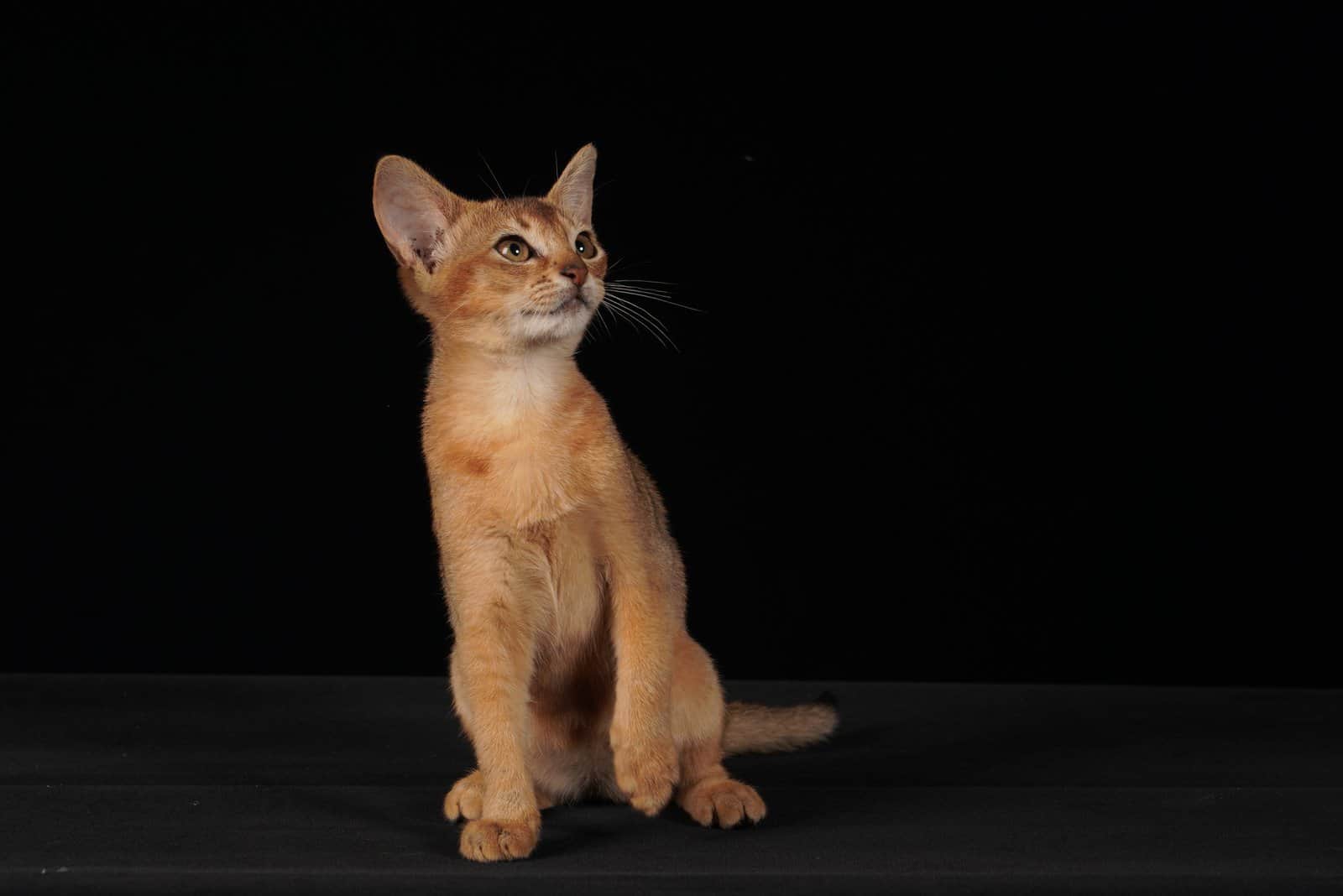
Abyssinian
The Abyssinian cat is a breed of domestic short-haired cat that has a ticked coat, or light and dark bands of colour on each hair shaft. The name comes from Abyssinia (now Ethiopia) because it is believed that Abyssinian cats have originated there. They are also referred to simply as Abys. Abyssinian cats are very intelligent, curious and playful. They love to explore, jump and climb.
Abyssinians are small to medium in size. Their average height is 20-25 centimetres. Males weigh 7 to 10 pounds and females weigh 6 to 8 pounds. Their lifespan is between 9 to 13 years. Their coats are soft and medium in length, and they come mainly in four colours: ruddy brown, red, blue and fawn. Kittens are born with dark coats that gradually lighten as they are growing up. They have rounded heads, broad ears, and eyes shaped like almonds in shades of gold or green. Their bodies are slim but muscular.

American Bobtail
The American Bobtail is an uncommon breed of domestic cats that looks similar to wild cats. Its main feature is that it has a short, bobbed tail. Despite their wild appearance, American Bobtails are friendly and devoted companion cats. They are also confident and intelligent with dog-like personalities. They like playing games like fetch and hide-and-seek.
American Bobtails have medium to large sturdy bodies. Their coats are shaggy medium-length to long that come in any colour or pattern. They can be black, white, blue, red, cream, chocolate, lavender, cinnamon, fawn and other colours. Their eyes come in various colours, too. Their average height is 20-25 centimetres. Males weigh around 6-7 kg, and females weigh around 3-5 kg. Their lifespan is between 15 to 20 years.

American Shorthair
The American Shorthair is a breed of domestic cat that is considered a working cat. It is believed to have been a European cat before it was brought to North America. When settlers sailed from Europe to North America, they carried cats on board to protect their cargo from mice and rats. These cates landed in their new world and adapted to their new life.
American Shorthair cats are adaptable and smart. They enjoy playing games that challenge their intelligence. They love attention from their owners, but they are also fairly independent. They may get along with other pets, but their hunting instincts may take over with birds and small animals.
The American shorthair cats have muscular bodies and legs. Their average height is about 20-25 centimetres. Males weigh around 5-7 kg, and females weigh around 3.6-5 kg. Their lifespan is between 15 to 20 years. American Shorthair cats have a large head, medium-sized ears and large, wide eyes. They are recognized in various colours and patterns, such as brown-patched tabby, blue-eyed white, shaded silvers, smokes and many other colours and patterns. The most common and popular, however, is the silver tabby.
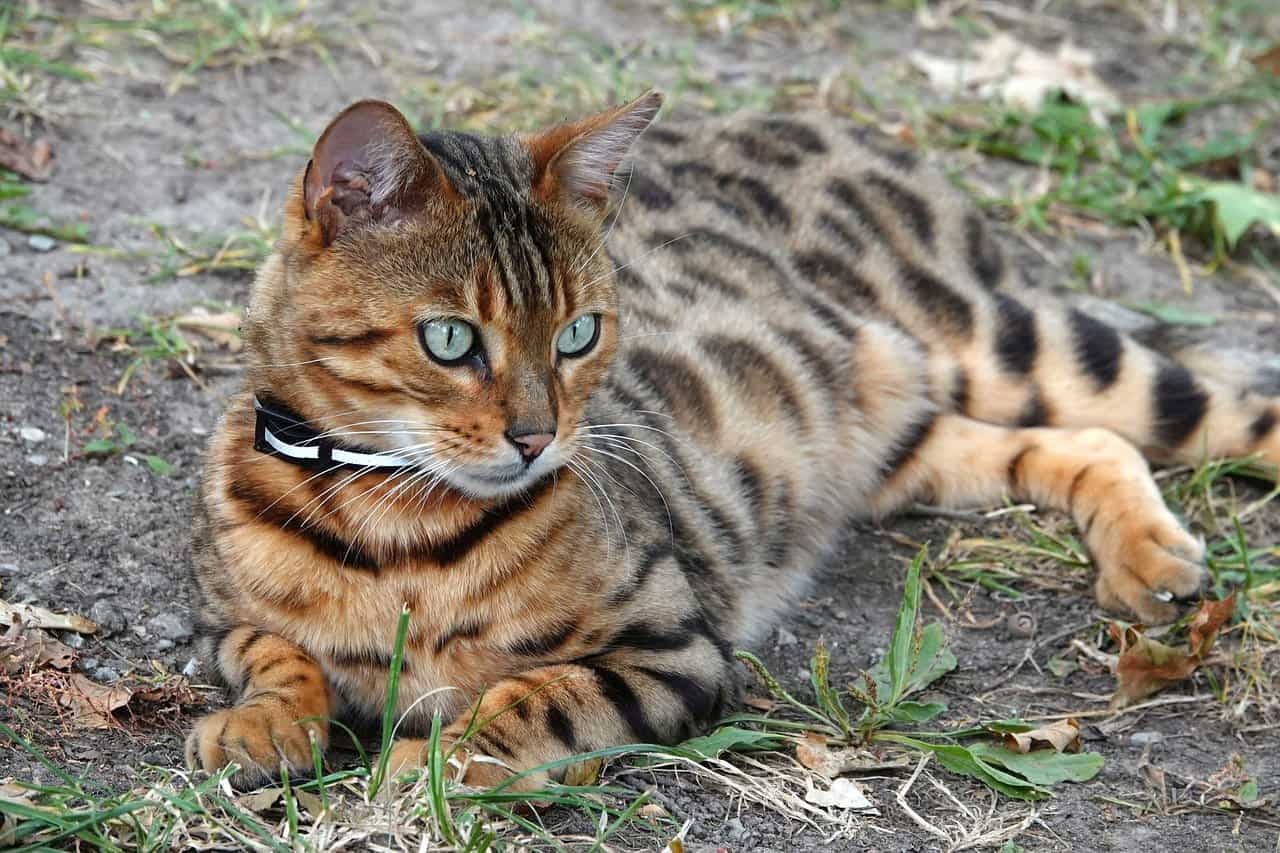
Bengal
The Bengal cat is a breed of domestic cats from hybrids of the Asian Leopard Cat with the Abyssinian and Egyptian Mau. The name comes from the scientific name for the Asian Leopard Cat “Prionailurus bengalensis.” Bengal cats are very intelligent, curious and confident. They are energetic cats that enjoy jumping and climbing around.
Bengals are medium-sized with wild appearance. Their coats have spots and markings that resemble those on leopards. The coats show different colours and patterns, such as contrasted shades of bright orange to light brown with dark spots, or a distinctive marbling pattern. Some Bengals have a glitter to the tip of their fur that glistens when the light hits it. The average height of Bengals is 20-25 centimetres. Males weigh around 4-7 kg, and females weigh around 2.5-5.5 kg. Their lifespan is between 9 to 16 years.
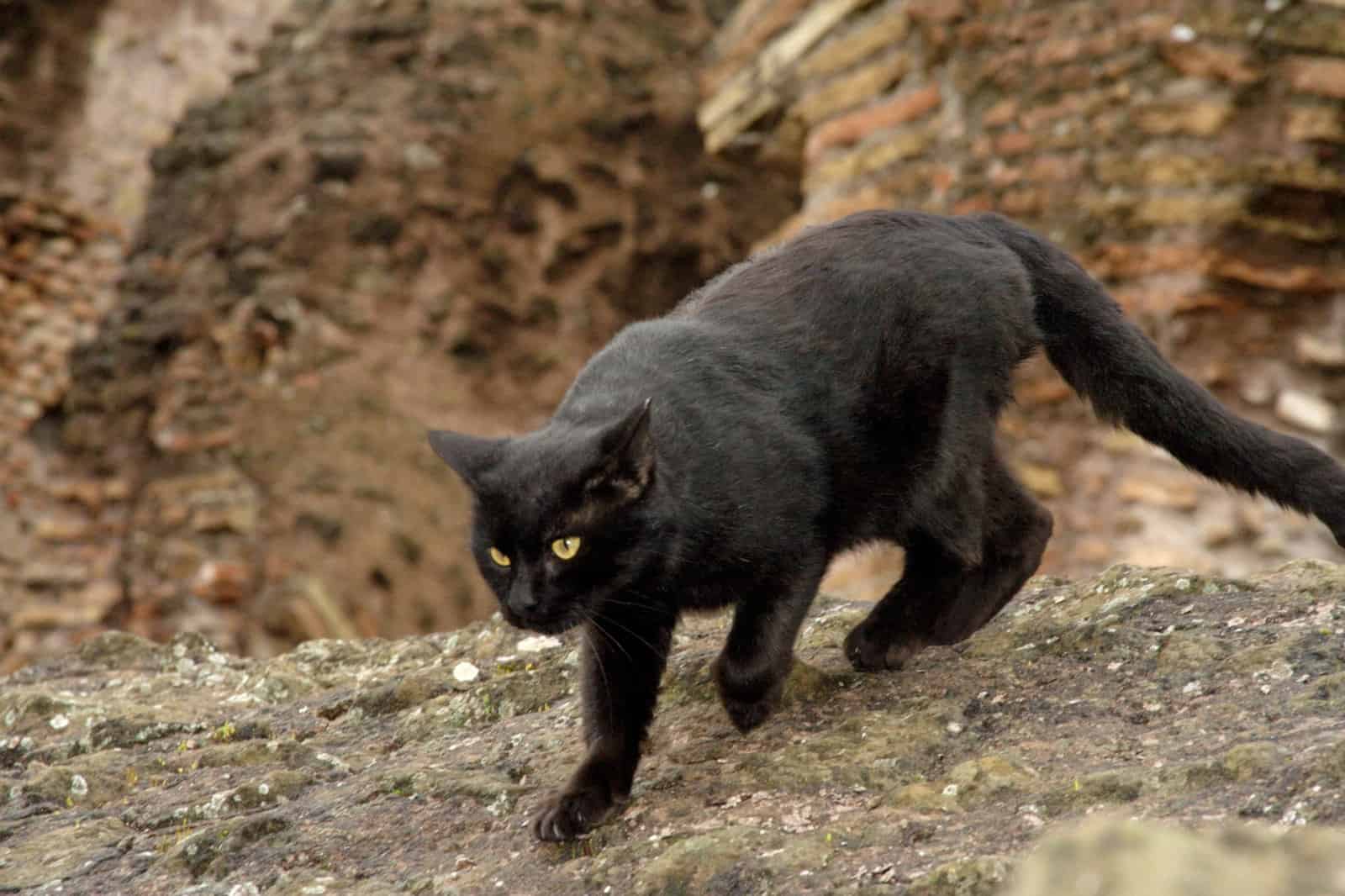
Bombay
The Bombay is a breed of short-haired domestic cats that is related to the Burmese. The most important feature of Bombay cats is their all-black coat with golden or copper eyes, resembling a wild panther. Bombay cats are energetic and smart. They enjoy playing games, and they learn tricks quickly.
Bombay cats have large, long bodies and long tails. Their average height is 20-25 centimetres. Males weigh around 3.5-5 kg, and females weigh around 2.5-4 kg. They have rounded heads and straight medium-sized ears. Their lifespan is between 12 to 18 years.
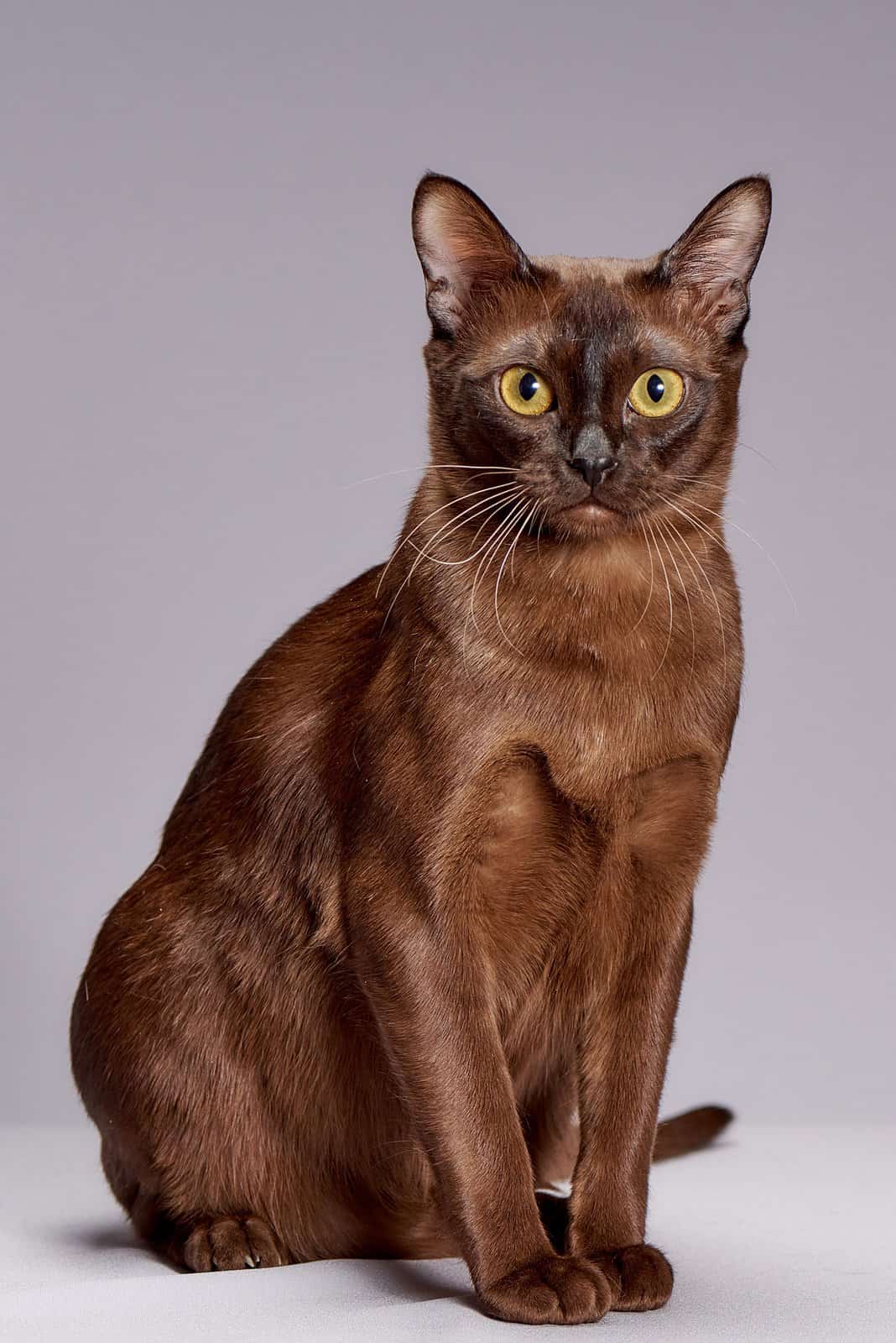
Burmese
The Burmese cat is a breed of domestic cat that originated in Burma but is believed to have developed in the United States and Britain. They bear a resemblance to the Bombay cats. Burmese cats are sociable, energetic, curious and playful. They love to explore and fetch objects. They also enjoy interactive toys and learning new tricks.
Original Burmese cats were all dark brown in colour, but the new lines come in a wide variety of colours. The colours include blue, champagne and platinum. Their coats are short and silky. They have green or golden eyes depending on their coat colour. Burmese cats have muscular bodies, rounded heads, and medium-sized ears. Their height is about 25-30 centimetres. Males weigh around 4-5.5 kg, and females weigh around 3.5-4.5 kg. Their lifespan is between 10 to 15 years.
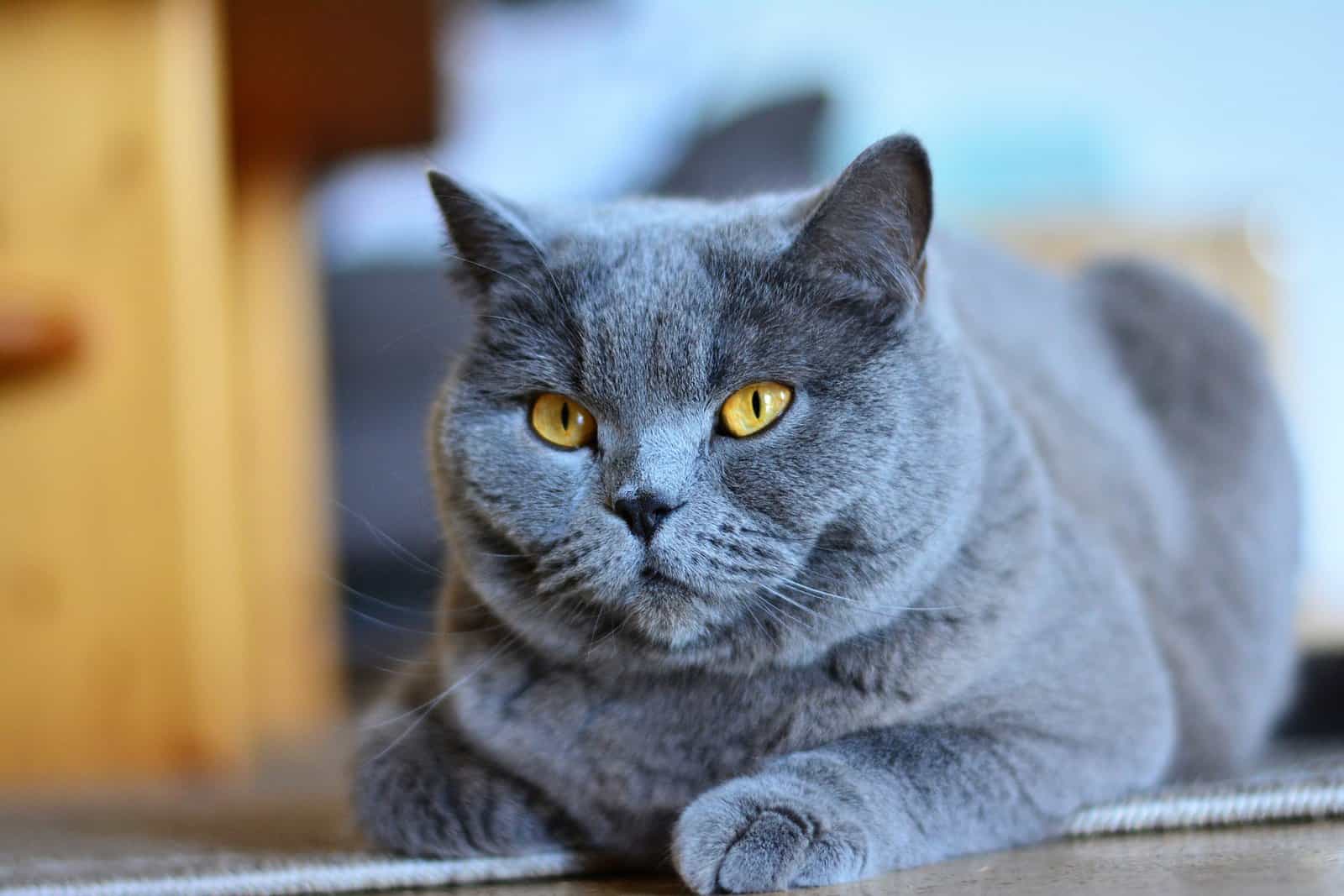
Chartreux
The Chartreux cat is a rare breed of domestic cat that is from France. Chartreux cats are great hunters. Farmers appreciate them for their hunting abilities. Chartreux cats are commonly known for their smile. In fact, the structure of their heads and their tapered muzzles make them appear to be smiling. Therefore, the Chartreux cat is often called “the smiling cat of France.”
The Chartreux cat is medium to large in size, with an average height of around 20-25 centimetres. Males weigh around 5-7 kg, and females weigh around 3-5 kg. Their lifespan is between 8 to 14 years. Chartreux cats have short-haired, woolly, blue coats. Their eyes’ colours are copper or orange.
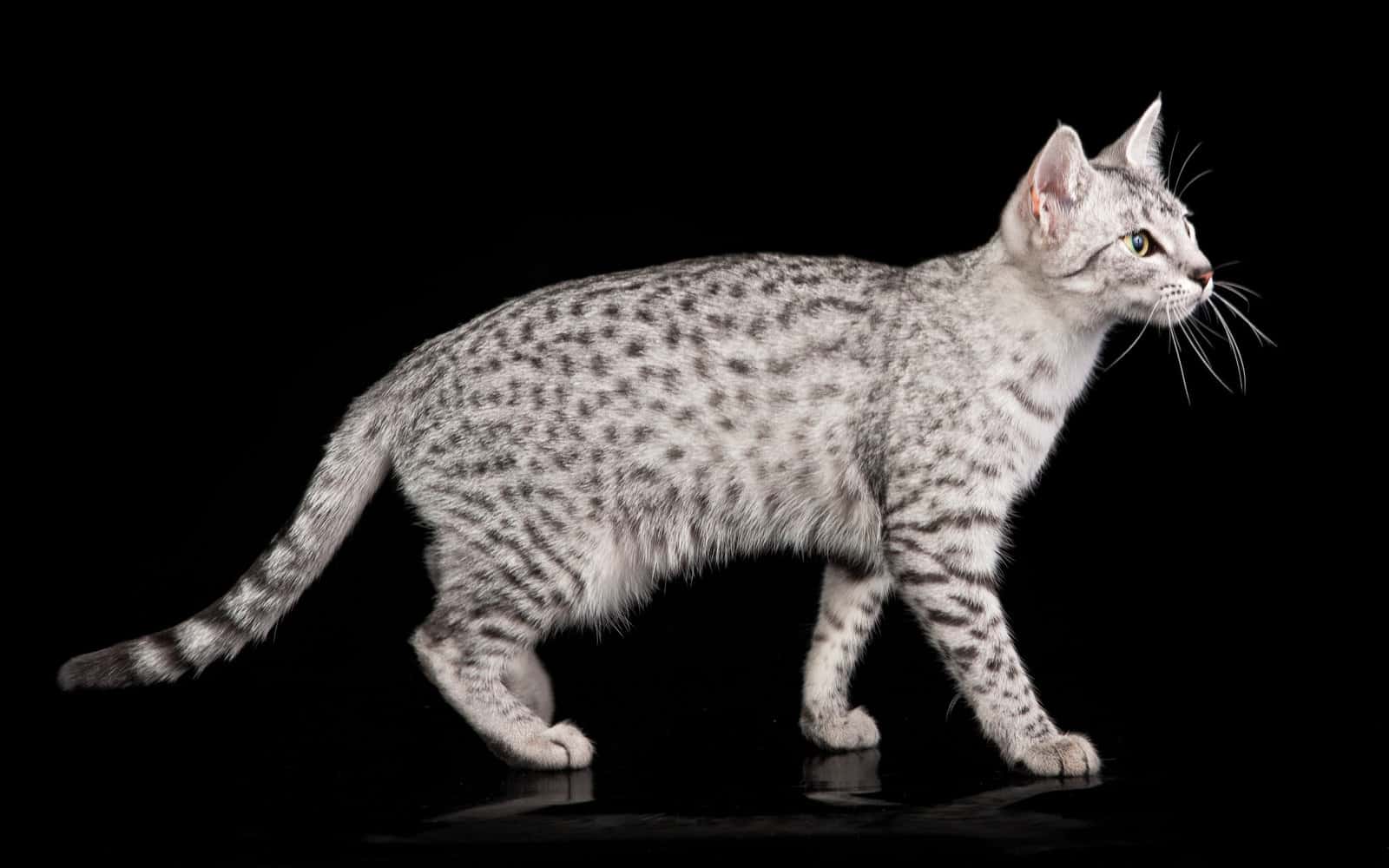
Egyptian Mau
The Egyptian Mau is a rare breed of short-haired domestic cats. The word “Mau” is the Egyptian word for cat. Egyptian Maus are highly active, energetic, friendly and smart. They also have good hunting skills.
Egyptian Maus are medium in size. Their average height is 20-25 centimetres. Males weigh around 3.5-5 kg, and females weigh around 2.5-3.5 kg. Their lifespan averages between 9 to 15 years. Egyptian Maus are the fastest of the domestic cats because they have longer hind legs. They have short-haired coats with spots on the tips of the hairs. They also have a long, dark, dorsal stripe that runs along the spine from their heads to their tails. Egyptian Maus come in around six colours, most commonly silver, black, bronze, smoke, caramel and blue. Their eyes are green.
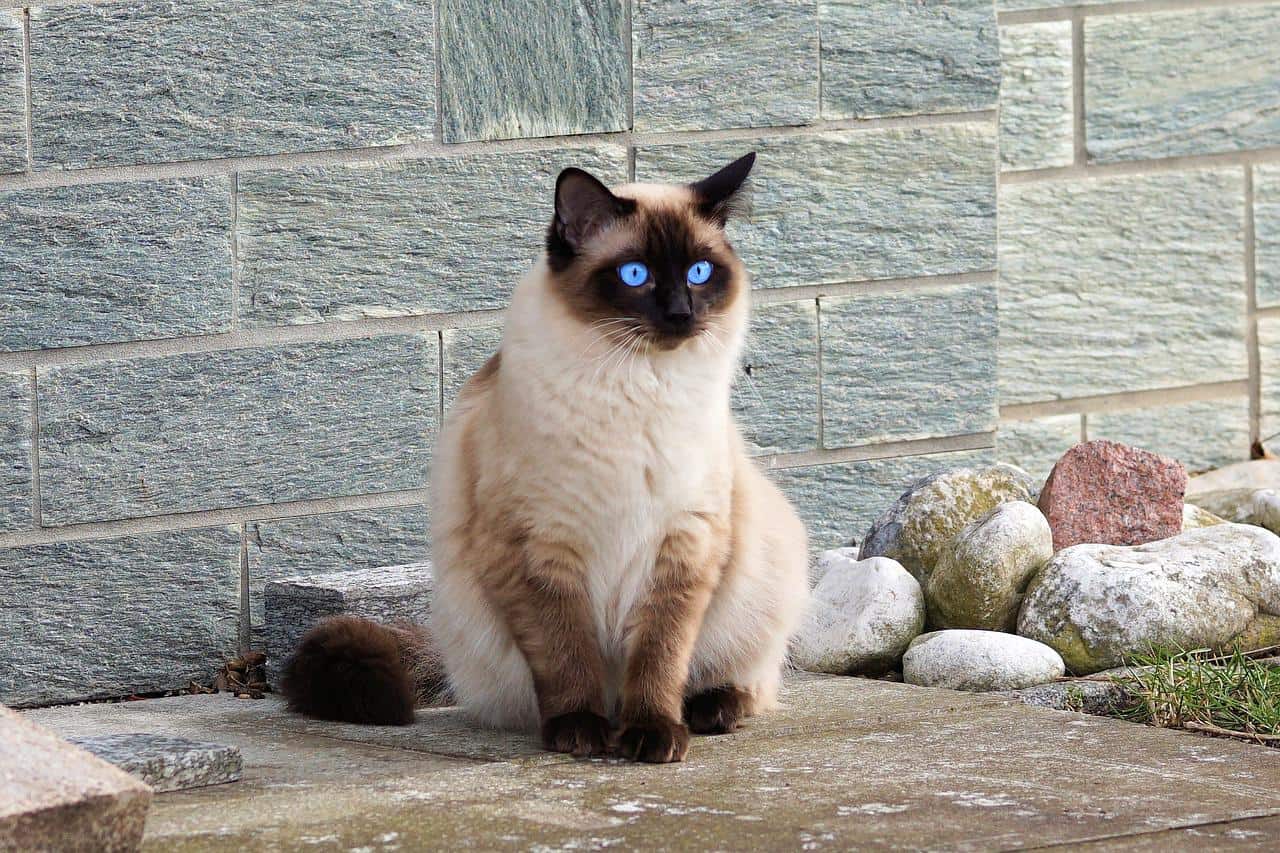
Siamese
The Siamese is a well-known breed of domestic cat from Thailand. Siamese cats get their name from Siam (Thailand today), where their ancestors were born. Siamese cats are so social, and they like companionship. They are intelligent, energetic, and playful. There are two types of Siamese cats: the Traditional Siamese, and the Modern Siamese.
Siamese cats are known for their distinctive appearance. Most of them have blue eyes and brown face, ears, tail and paws. Their coats have a kind of pattern called point coloration. It means that their bodies are pale and their faces, ears, feet and tails are dark. They have triangular heads, almond-shaped eyes, and large ears. They are small to medium in size, and their bodies are long and muscular. The average height of a Siamese cat is 20-25 centimetres. Males weigh around 4.5 to 7 kg, and females weigh around 3.5 to 5 kg. Their lifespan is between 11 to 15 years.
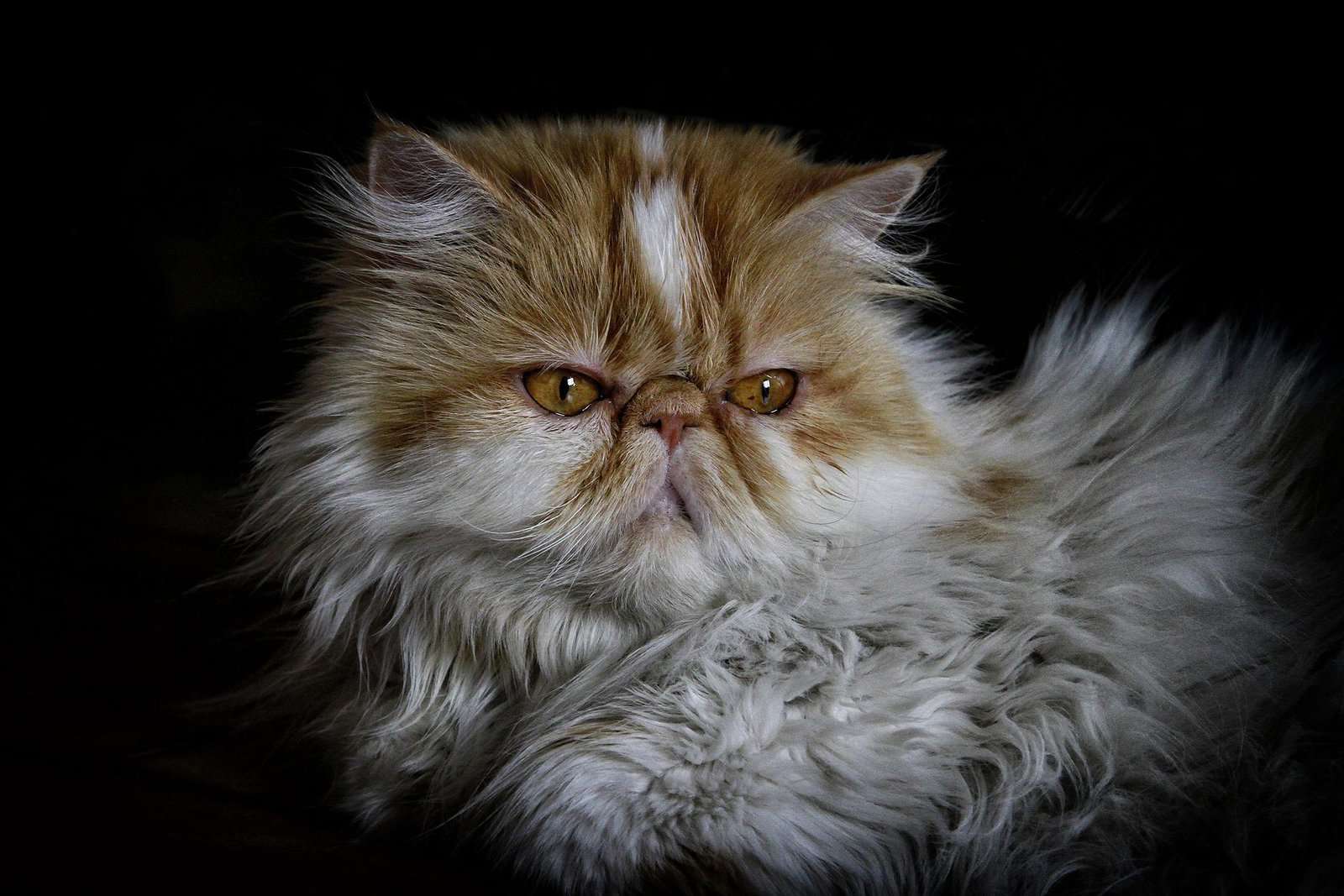
Persian
The Persian cat is one of the common breeds of long-haired domestic cats. It is known for its round face and short muzzle. Persian cats are not the most active cats. They are often quiet and calm. Persian cats are medium to large in size. Their average height is 20-25 centimetres. Males weigh around 3-5 kg, and females weigh around 3-4 kg. Their lifespan is between 12 to 17 years.
A Persian cat generally has a round head, a short face, large eyes, a small nose, chubby cheeks, and rounded ears. The body of Persian cats is strong and muscular. Their legs are short but strong, and their tails are thick. Persian cats have long, thick coats that are usually white, but they sometimes come in other colours such as black, blue, cream, and red. Their eye colours vary according to the coat colour; for example, a white Persian often has blue eyes, while a silver or golden one often has green eyes.
Himalayan
The Himalayan cat is a breed of long-haired domestic cat that was created from crosses of the Siamese with the Persian. The Himalayan cat has the body type of the Persian cat but the colourpoint pattern of the Siamese. It is known for having the best characteristics of both breeds. Himalayan cats are sweet and quiet cats.
Himalayan cats are medium to large in size, with an average height of 25-30 centimetres. Males weigh around 5-6 kg, and females weigh around 3.5-5.4 kg. Their lifespan is between 9 to 15 years.
The Himalayan cat has a round head, round eyes, a short nose, small ears, and chubby cheeks. It has a muscular body with a thick neck and short but strong legs. Its short legs with a stubby body make it harder for it to jump as high as other cats can do. Himalayan cats have thick, long and glossy coats that are light-coloured, and they have darker faces, ears and tails. Their bodies come in many colours, but their eyes only come in blue, like the Siamese.
If you enjoyed learning about this facinating animal why not check out more fantastic facts about other animals: Koalas, Land Animals, Sharks, Raccoons, Moon and Sun Bears, Rats, Sheep, Chickens, Pandas, Monkeys and Whales.
Why not subscribe for as little as £1.99 per month to access over 1000 fun educational videos!


Leave a Reply